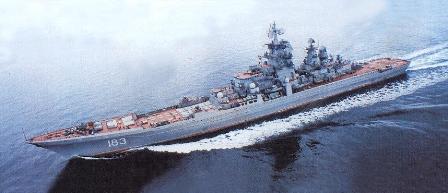Kirov-class (Project 1144 Orlan)
Summary
| Origin country | 🇨🇳 Ex-USSR |
| Category | Cruiser |
| Subtype | Nuclear squadron missile cruiser |
| Manufacturer | Baltic Shipyard |
| Year commissioned | 1980 |
| Units |
080 Admiral Nakhimov 099 Pyotr Velikiy |
| Current operators | 🇷🇺 Russia |
Description
The Kirov class, designated Project 1144 Orlan, originated in the Soviet Union. Initially conceived as a large anti-submarine warfare platform, its design purpose evolved to counter entire U.S. Navy carrier strike groups. These battlecruisers were intended to operate alongside a new generation of Soviet nuclear-powered aircraft carriers which were never completed. Construction on the lead ship began in 1974, and its commissioning in 1980 was a significant event, contributing to the United States' decision to recommission its Iowa-class battleships. Original plans called for five ships, but only four were completed before the fifth was cancelled in 1990.
Designated as a heavy nuclear-powered guided-missile cruiser, the Kirov class represents the largest and heaviest surface combatant warships in operation, comparable in scale to a World War I-era battleship. Propulsion is provided by a combined nuclear and steam system, allowing for virtually unlimited range when operating on nuclear power. Its offensive firepower is centered on a substantial battery of heavy anti-ship cruise missiles designed to engage major surface targets. A layered air defense is provided by long-range and point-defense surface-to-air missile systems, with one vessel reportedly capable of ballistic missile defense. Anti-submarine capabilities include rocket launchers and torpedo tubes that can also launch anti-submarine missiles. Armament is completed by dual-purpose guns and close-in weapon systems. The vessel can carry several helicopters, supported by a below-deck hangar, and is equipped with a comprehensive suite of search and fire-control radars as well as hull-mounted and variable depth sonar. Modernization programs for surviving units are extensive, planning for the integration of new vertical launch systems and hypersonic weapons.
Upon entering service, the vessels were assigned to the Soviet Northern and Pacific Fleets. The operational history of the class has been significantly impacted by funding and maintenance challenges following the dissolution of the Soviet Union. The lead ship was forced into reserve after suffering a reactor accident in 1990 during a Mediterranean deployment. Another vessel was rendered inactive and eventually decommissioned, with scrapping commencing in 2021. As a result, only one battlecruiser of the class remains active, serving as the flagship of Russia's Northern Fleet. A third ship has been undergoing a protracted refit and modernization since 1999, with plans to overhaul the last active ship upon its sister’s eventual return to service.
Technical specifications
| Displacement | 24300 tons |
| Range | 1000 km at 30 knots |
| Crew | 710 members |
| Width | 28.5 m (93.5 ft) |
| Length | 252.0 m (826.8 ft) |
| Air Park | 3 × Kamov Ka-27 helicopters |
| Propulsion | 2-shaft CONAS, 2× KN-3 nuclear marine propulsion with 2× GT3A-688 steam turbines 140,000 shp |
| Thrust | 18000 hp |
| Armament | * 20 × P-700 Granit (SS-N-19 Shipwreck) AShM |
| Maximum speed | 32 knots |
